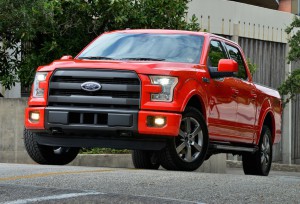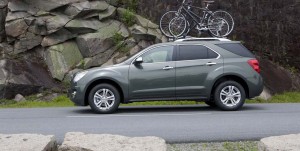
Low gas prices are helping to drive sales of full-size pickups like the Ford F-150, which is forcing makers to add jobs.
The sharp slump in fuel prices has generally been good news for auto buyers and automakers alike. A growing number of buyers have been shifting from high-mileage cars to bigger pickups and utility vehicles in recent months.
For manufacturers, that has swelled the bottom line since those vehicles tend to deliver some of the industry’s largest profits. But not everyone is celebrating. While companies, like Ford and GM, have been responding by increasing production of their best-sellers, they’re also trimming back at under-utilized car plants.
And that trend could continue going forward. Industry analysts anticipate that utility vehicles will outsell sedans for the first time ever in 2015, while pickups will report their best year since the economic slump began.
Ford today announced it will add 400 new jobs at the Oakville, Ontario, plant producing its newly updated Edge crossover-utility vehicle. That’s on top of the 1,000 new jobs it had announced last year as it began to renovate the facility near Toronto.
The CUV has been gaining momentum in the U.S., but Ford also plans to expand exports, shipping the Edge to Europe for the first time.
Ford has also been expanding its workforce at the two plants that produce its big F-150 pickup, which was completely redesigned for the 2015 model-year, migrating from steel to a lighter, more fuel-efficient aluminum body.
The pickup plant in Dearborn, Michigan, began producing the new model late last year, and Ford expects to have the retooled truck line in Kansas City, Missouri, up and running by the end of March. All told, when they’re both operating at full speed, the factories will be capable of turning out 700,000 of the full-size trucks annually.
The F-150 has not only been the perennial best-selling truck in the U.S. market, but also the top-selling vehicle overall. And Ford is betting that between the surge in the truck market and the strong reviews the 2015 F-150 has been getting, demand will grow.
Ford isn’t the only one benefitting from the surge in truck demand. General Motors is set to add a third shift at the Wentzville, Missouri plant producing two new midsize pickups, the Chevrolet Colorado and GMC Canyon, as well as its full-size commercial vans. It has been running three shifts flat out at a plant in Arlington, Texas producing full-size SUVs such as the Chevrolet Suburban, GMC Yukon XL and Cadillac Escalade.
That isn’t the case for the vehicles being produced at GM’s car plant in the Detroit suburb of Orion, Michigan. Demand for models like the Chevrolet Sonic have been lagging well behind the overall U.S. market recovery, and the maker plans to briefly idle the plant from March 9-13. That marks the second cutback at Orion since the beginning of this year. GM also will trim back production at its own suburban Toronto plant between April 13–17.
At a news conference prior to the Detroit Auto Show last month, GM CEO Mary Barra stressed the company’s new religion, which is to build to market demand, rather than trying to push unpopular vehicles onto the market with hefty incentives that eat away at earnings.
Industry analysts expect the production and job shifts to continue. “We expect to see utility vehicles outsell sedans for the first time this year,” said Analyst Stephanie Brinley of IHS Automotive.
(Consumer Reports names top brands and models. For more, Click Here.)
Last month alone, sales of the Chevy Suburban rose 142% while demand for the little Sonic fell more than 46%, according to Autodata, which tracks industry sales. All trucks – including pickups, vans SUVs and CUVs – gained 19.3% in January, while car sales rose just 7.7%, well below the overall pace of a hot market.
Trucks, which had been losing share to cars during the Great Recession, as fuel prices soared to record levels, have more than recovered. They now account for 54% of the U.S. market, up from 51.4% a year ago.
(Click Here for details about Lexus topping the Power dependability study.)
That could shift again, of course, Brinley and other analysts caution, should fuel prices surge upward again. But few expect to see $4 gas anytime soon. Meanwhile, manufacturers are racing to improve the fuel economy of their trucks. Ford boosted mileage significantly with the switch to lightweight aluminum. Several makers are developing new hybrid drivetrains for their utility vehicles.
(To see why recall numbers are expected to remain high, Click Here.)
So, if current trends hold, expect to see even more job cuts on the car side, industry observers anticipate, while the Help Wanted sign will likely be seen outside a number of truck plants.


I can understand people who have the need, buying utility vehicles, i.e. SUVs but I find it odd that many people buy pick-up trucks when they have virtually no use for the truck features. Some folks actually believe the trucks have better styling than the cars. One thing we know for certain, pick-up trucks suck in snow unless they have weight added to the bed for increased traction.
Agreed Jorge. Aside from a few Chrysler and one Chevy (a captive Holden with a bow-tie), those that really want today’s version of a V8 RWD muscle car are left with choosing a pickup or full-size SUV. I believe that is what declining gas prices always reveals. And, a lot of pickups up here in central New York are hauling snow in their beds. A great way for lazy drivers to reduce already poor gas mileage.
I do not believe that people are buying pick-ups to replace muscle cars. There are numerous U.S. brand muscle cars available be it the Mustang, Challenger, Camaro or even upscale models like the Corvette and Viper. You can even get a luxo muscle car in the Cadillac V series . If you need more muscle then you can buy a Shelby Mustang or a Dodge Hellcat. The muscle car still lives on in the U.S. brands.
People buying utility vehicles are predominantly buying SUVs. Trades people and those with a specific need or desire are also buying pick-ups which have more deluxe interiors and infotainment systems these days akin to cars. SUVs however are popular and practical for many reasons where as pick-up trucks are more limited.
If we had roadways and speed limits like in Germany, you’d see a lot more car sales than utility vehicle sales.
BTW, what pick-up drivers in snowy areas should be hauling is about 300 lbs. of securely retained cinderblock in the bed of their truck for safety and traction. I’ve had the back of a pick-up truck try and pass the front of the pick-up truck while going up hill on a snow covered road – due to insufficient rear weight/traction.